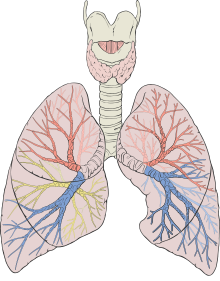windpipe
The windpipe or Latin trachea (from ancient Greek τραχύς trachýs , 'rough'; what is meant is "the rough tube", "the coarse artery" - in contrast to the finer blood vessels) is the connection between the larynx and the bronchial system of the lungs in vertebrates . It belongs to the respiratory tract and is used for air conduction.
development
Historically , the trachea first appeared in amphibians . Hence, it can be assumed that this organ was developed around 350 million years ago. Some dinosaurs had the longest windpipes with a length of around 10 m.
Like the entire lower respiratory tract, the trachea in the embryo arises from a sprouting of the foregut .
Mammalian anatomy
The windpipe is an elastic tube and begins at the larynx . Here it lies at the front of the stomach ( ventral ) of the esophagus and then pulls along the neck to the right of it to the chest . Inside the thorax it is again located on the belly of the esophagus and divides into the two main bronchi ( bronchi principales ) at the level of the 4th to 5th thoracic vertebra in the tracheal fork ( bifurcatio tracheae ).
In adults, it is 10–12 cm long and reinforced by 16 to 20 horseshoe-shaped hyaline cartilages ( cartilagines tracheales ) in its front wall, so that it cannot collapse even when inhaled. The cartilage clasps themselves are connected by ligaments - the ligamenta anularia - while the posterior wall ( paries membranaceus ) consists of connective tissue and muscular (tracheal muscle , musculus trachealis ) structures. This muscular component can narrow the lumen of the windpipe by a quarter.
The cartilage skin of the cartilage braces radiates into the ligamenta anularia. The mucous membrane of the trachea is firmly fused with the cartilage skin, but freely movable in the part lying in the posterior wall, so that longitudinal folds can form when the tracheal muscle contracts. Between these folds glands ( glandulae tracheales ) open , which form a seromucosal secretion . Via the orderly activity of the multi-row ciliated epithelium ( respiratory epithelium ), mucus and dust particles are transported upwards and coughed up or cleared.
In this mucous membrane, which lines the entire inner wall of the windpipe, goblet cells and neuroendocrine cells are also distributed, whereby the latter can lie together as neuroepithelial bodies and belong to the APUD system. Like those in the bronchi, these serve as chemoreceptors to monitor the breathing gases.
clinic
Foreign bodies that have got into the windpipe trigger the cough reflex . If they cannot be coughed up, the foreign body aspiration can lead to suffocation.
An inflammation of the windpipe is called tracheitis . It can be infectious , allergic or caused by chemical stimuli. It is often combined with inflammation of the larynx ( laryngitis ) ( laryngotracheitis ). If there is additional inflammation of the bronchi, one speaks of tracheobronchitis . A softening of the cartilage rings ( tracheomalacia ) leads to the fact that the windpipe collapses, especially during the inhalation phase (see also tracheal collapse of the dog ). A narrowing of the windpipe can also be caused by space-consuming processes in the area around the windpipe ( saber-sheath trachea ) and by cancer of the windpipe . Narrowing of the windpipe (tracheal stenosis ) usually leads to a humming noise known as the stridor trachealis .
Surgical opening of the windpipe ( tracheotomy ) is an emergency measure when the upper airway is obstructed. During anesthesia , an endotracheal tube is placed into the windpipe to maintain the air flow and avoid breathing in foreign material ( endotracheal intubation ).
A malacia of the trachea can be congenital or acquired (after a long ventilation) and will occur as tracheomalacia designated.
Small bulges in the windpipe ( tracheal diverticulum ) can be congenital or acquired and are usually of no clinical significance.
The tracheo-oesophageal fistula and tracheomalacia are congenital malformations (or acquired diseases) .
In birds, the windpipe is the seat of the windpipe worm .
literature
- Franz-Viktor Salomon: respiratory system. In: Franz-Viktor Salomon, Hans Geyer, Uwe Gille (Ed.): Anatomy for veterinary medicine. 2nd, revised and expanded edition. Enke, Stuttgart 2008, ISBN 978-3-8304-1075-1 , pp. 324-367.
Web links
Individual evidence
- ^ Wilhelm Gemoll : Greek-German school and hand dictionary . G. Freytag Verlag / Hölder-Pichler-Tempsky, Munich / Vienna 1965.
- ^ Pschyrembel: Medical Dictionary . 257th edition. Walter de Gruyter, Berlin 1993, ISBN 3-933203-04-X , p. 1551 .
- ↑ Joachim Frey : Diseases of the respiratory organs. In: Ludwig Heilmeyer (ed.): Textbook of internal medicine. Springer-Verlag, Berlin / Göttingen / Heidelberg 1955; 2nd edition ibid. 1961, pp. 599-746, here: pp. 635-640 ( tracheobronchitis ).
- ↑ A. Tanrivermis Sayit, M. Elmali, D. Saglam, C. Celenk: The diseases of airway-tracheal diverticulum: a review of the literature. In: Journal of thoracic disease. Volume 8, number 10, October 2016, pp. E1163 – E1167, doi: 10.21037 / jtd.2016.10.92, PMID 27867581 , PMC 5107528 (free full text) (review).


